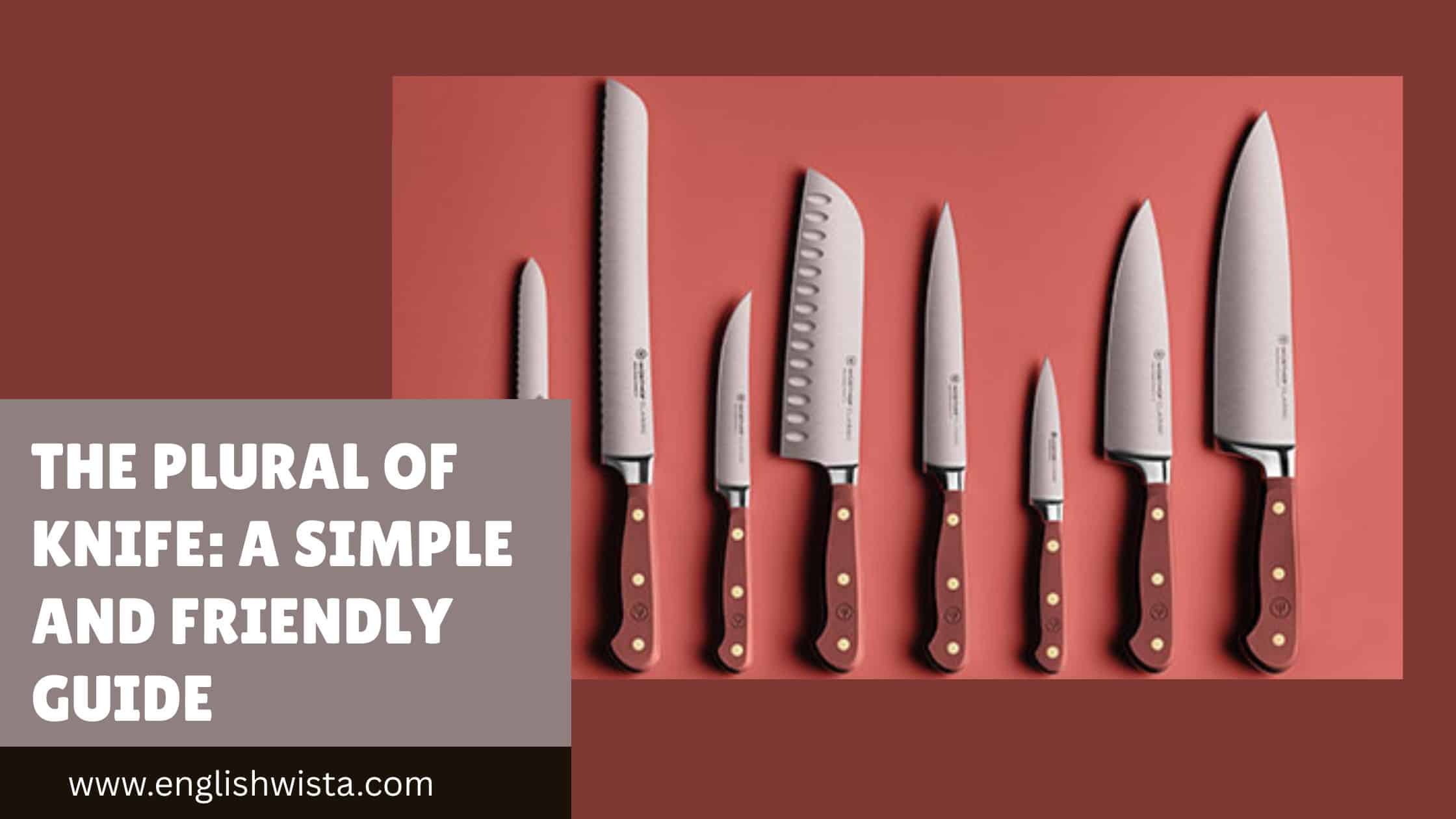Have you ever been at a dinner table, looked around, and thought, “Wait, if I have one knife, what do I call two?” You’re not alone! English can be a little tricky when it comes to plurals, especially with words that don’t follow the usual pattern of just adding an s at the end.
The word knife is one of those special cases. Many learners of English, and even native speakers, get confused about how to make it plural. But don’t worry we’re going to break it down step by step, using simple explanations and lots of examples. By the end of this article, you’ll know exactly how to use the plural of knife in everyday conversations, writing, and even in fun little trivia facts.
So, grab your favorite snack (don’t worry, no knives required yet!) and let’s dive in.
What Is the Plural of Knife?
The plural of knife is knives.
Notice how the f at the end changes into v, and then we add es:
- knife → knives
This is the standard plural form in English when certain words end with -f or -fe. Instead of just adding an s, the f often changes to v before adding es.
Here’s the transformation clearly:
- One knife
- Two knives
It might look strange at first, but this pattern is quite common in English. Let’s take a closer look at why this happens.
Why Does Knife Become Knives?
English spelling rules sometimes follow patterns, and one of those patterns is about words ending in f or fe.
For many of these words, the f changes to v in the plural form. Then we add es.
Here are a few examples:
- leaf → leaves
- wolf → wolves
- wife → wives
- life → lives
Notice how they all follow the same pattern as knife → knives.
Of course, English wouldn’t be English without exceptions! Not every word ending in f follows this pattern. For example:
- roof → roofs (not rooves)
- chief → chiefs (not chieves)
But knife definitely follows the f → v + es rule.
Is Knife Singular or Plural?
This is a very common question!
- Knife is singular. It means just one cutting tool.
- Example: I need a sharp knife to cut this apple.
- Knives is plural. It means more than one.
- Example: The chef keeps all his knives neatly arranged.
So, whenever you’re talking about a single tool, you say knife. When you’re talking about two or more, you say knives.
Example Sentences Using Knife and Knives
The best way to learn is by seeing the words in action. Here are some simple, everyday examples:
Singular (knife):
- She bought a new knife for cooking.
- Be careful with that knife; it’s very sharp.
- This knife belongs in the top drawer.
Plural (knives):
- The restaurant has hundreds of shiny knives.
- Please put the knives and forks on the table.
- Hunters often carry hunting knives.
Notice how natural it sounds when we use the correct form in each sentence.
A Quick Definition of Knife
Let’s pause for a moment and define the word clearly.
A knife is:
- A tool or utensil with a blade and a handle, used for cutting food, objects, or other materials.
That’s it! Very simple. And now, whenever you’re using more than one, you just say knives.
Comparing Knife with Other Similar Words
Sometimes it helps to compare. Let’s look at a few words that are like knife:
- Life → Lives
- One life, many lives.
- Wife → Wives
- One wife, several wives.
- Elf → Elves
- One elf, a group of elves.
See the pattern? The f or fe often turns into ves when we make it plural.
So when you’re unsure about a word ending in f, think: does it change to ves? Most of the time, yes.
Common Mistakes Learners Make
Because the spelling looks a bit unusual, learners often make small mistakes when writing the plural of knife. Let’s look at a few and fix them:
- ❌ knifes → This is wrong.
- ✅ knives → This is correct.
- ❌ knive → Also wrong.
- ✅ knives → Correct again.
The trick is always to remember: f → v + es.
Fun Facts About the Word Knife
Learning grammar doesn’t have to be boring. Here are some fun tidbits about knife and knives:
- Old English roots: The word knife comes from Old Norse (the language of the Vikings). The Old Norse word knífr meant the same thing a blade.
- Silent k: Have you noticed that the k in knife is silent? We don’t say kuh-nife; we just say nife. This silent k comes from old pronunciations in Middle English, where people used to say the k sound. Over time, it disappeared, but the spelling stayed the same.
- Collective noun for knives: Did you know there’s even a fun collective noun for a group of knives? It’s sometimes called a set of knives or even a draw of knives (from the kitchen drawer they’re often kept in).
- Knives in culture: In many cultures, giving someone a knife as a gift is considered bad luck unless the person gives you a coin in return. The coin “pays” for the knife so it doesn’t symbolically “cut” the friendship.
Quick Memory Trick
Here’s a simple way to remember the plural:
Think of this little phrase:
“One knife, many knives just change the f to v and add es.”
Repeating this a few times makes it stick in your memory.
Real-Life Scenarios Where You Might Use Knife/Knives
Let’s imagine some everyday conversations:
At a restaurant:
- Waiter: Would you like another knife?
- Customer: Yes, please. These knives aren’t very sharp.
In the kitchen:
- I can’t find the bread knife.
- Don’t worry, we have other knives we can use.
Shopping:
- This store sells Japanese cooking knives.
- I only need one knife for now.
See? Once you know the rule, it becomes easy to use.
Other Interesting Plural Forms Like Knife → Knives
Let’s practice with a few other words that change in the same way:
- Calf → Calves
- Shelf → Shelves
- Half → Halves
- Thief → Thieves
You can spot the pattern right away. If you master these, you’ll never mix them up again.
Summary of Key Points
Let’s bring everything together:
- The plural of knife is knives.
- The f changes to v, and then we add es.
- Knife is singular; knives is plural.
- Common mistake: writing knifes instead of knives.
- The word knife comes from Old Norse and has a silent k.
- Other words with the same pattern include life → lives and wolf → wolves.
Conclusion
So, the next time you’re in the kitchen or writing an English sentence, you won’t have to pause and wonder, “Is it knifes or knives?” You’ll know it’s knives, with that special spelling change.
English can feel confusing with its little rules and exceptions, but when you break things down step by step, it all starts to make sense. Remember the simple rule: f → v + es. That’s all you need for knife.
Now you’re ready to impress your friends at the dinner table, in class, or even at trivia night. Who knew that learning the plural of knife could be this fun?
And just to leave you smiling: the next time you pick up a knife, you’ll know it’s sharp not just in the kitchen, but in your English skills too!



